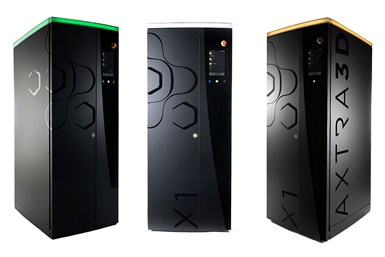Axtra3D’s X1 Series 3D Printers Powered by Vat Polymerization Technologies
The X1 and Revox X1 3D printers are powered by vat polymerization technologies, including Hybrid PhotoSynthesis (HPS), TruLayer technology and the Intelli-Cartridge system to deliver fine resolution, large print area, excellent surface quality and high speed in one machine.
X1 Series Printers from Axtra3D enable production speed and quality without the tradeoffs. Photo Credit: Axtra3D
Axtra3D says its X1 and Revox X1 3D printers are powered by next-generation vat polymerization technologies, including Hybrid PhotoSynthesis (HPS), TruLayer technology and the Intelli-Cartridge system. Together these technologies are said to deliver fine resolution, large print area, excellent surface quality and high speed in one machine.
According to the company, familiar SLA, DLP and LCD 3D printing technologies all require tradeoffs. HPS is a hybrid process designed to enable speed and quality without compromise. This technology combines two different light sources, DLP and laser, to leverage the best of each without the tradeoffs of either. HPS coalesces the energy from the two light sources, creating a harmonized light engine that efficiently harnesses the power and competencies of the two sources.
HPS also delivers the speed of DLP and LCD processes with the ultrafine resolution of SLA, all without familiar aliasing defects, anisotropy or tiny build volumes. The large build area of Axtra3D’s HPS-powered systems produce isotropic parts with fine feature finish. Quality, speed, scale and significantly reduced postprocessing for surface finish are said to deliver new possibilities for medical, dental and other meticulous industries.
Axtra3D’s TruLayer technology is on every X1 Series printer, offering several distinct advantages. It enables rapid detachment of the active print layer from the vat membrane and no limitations to the cross sections being printed, including large and bulky cross sections. Another advantage is the nondegenerative vat membrane, which means fewer membrane replacements. It also offers the ability to print highly viscous resins. Faster speeds, better layering and deep materials understanding are said to power this process, enabling superior separation and adaptive performance.
The Intelli-Cartridge system adds user-friendliness to resin material handling. Debuting with the X1 Series, Intelli-Cartridge enables both open and closed material configurations, offering users the highest level of freedom to ensure they have the materials capabilities for their specific applications. Axtra3D is poised to offer third-party and in-house materials directly, and has validated filled and unfilled resins from some of the best-known brands active in 3D printing today.
With the Intelli-Cartridge, materials are virtually spill-proof and free of contamination. It actively dispenses material to the vat and also collects the return material from the vat. The Intelli-Cartridge enables 3D printing of high-performance materials by offering agitation, heating and filtering mechanisms.
Axtra3D’s X1 Series printers include the production-grade Lumia X1 and the budget-friendly Revox X1 which is a 4K DLP system powered with TruLayer technology. The build volume and Intelli-Cartridge capabilities of the Lumia X1 are identical for the Revox X1.
The Lumia X1 is said to offer unrivaled quality at speed. Designed to outperform photopolymer 3D printers available to date, the HPS-powered Lumia X1 offers 24/7 lights-out production. It is also equipped with TruLayer technology to offer excellent production economics, uptime, repeatability and printability. Possible only with HPS + TruLayer technology, users gain the speed of 3D printing with the fine finish of injection molding. It also offers a large build area with 45-micron resolution, all with the material handling ease of Intelli-Cartridge.
The Revox X1 system is poised to deliver unprecedented 4K DLP 3D printing. It is a high-quality, reliable and repeatable DLP 3D printer at an attractive entry price point for budget-limited customers who can accept DLP part quality. The only difference from the otherwise-identical Lumia X1 is that the Revox X1 does not harness HPS technology. If, however, a customer later wants to commit to HPS, an upgrade path from Revox X1 to Lumia X1 will be offered. This industrial 3D printing platform is built using high-end optoelectronics with top-of-the-line mechatronics to ensure a highly repeatable print process ready to work from day one.
Related Content
3D Printed Spine Implants Made From PEEK Now in Production
Medical device manufacturer Curiteva is producing two families of spinal implants using a proprietary process for 3D printing porous polyether ether ketone (PEEK).
Read MoreCopper, New Metal Printing Processes, Upgrades Based on Software and More from Formnext 2023: AM Radio #46
Formnext 2023 showed that additive manufacturing may be maturing, but it is certainly not stagnant. In this episode, we dive into observations around technology enhancements, new processes and materials, robots, sustainability and more trends from the show.
Read MoreQ&A With Align EVP: Why the Invisalign Manufacturer Acquired Cubicure, and the Future of Personalized Orthodontics
Align Technology produces nearly 1 million unique aligner parts per day. Its acquisition of technology supplier Cubicure in January supports demand for 3D printed tooling and direct printed orthodontic devices at mass scale.
Read More6 Trends in Additive Manufacturing Technology at IMTS 2024
3D printers are getting bigger, faster and smarter. But don’t overlook the other equipment that the AM workflow requires, nor the value of finding the right supplier.
Read MoreRead Next
Alquist 3D Looks Toward a Carbon-Sequestering Future with 3D Printed Infrastructure
The Colorado startup aims to reduce the carbon footprint of new buildings, homes and city infrastructure with robotic 3D printing and a specialized geopolymer material.
Read More3D Printed Polymer EOAT Increases Safety of Cobots
Contract manufacturer Anubis 3D applies polymer 3D printing processes to manufacture cobot tooling that is lightweight, smooth and safer for human interaction.
Read MoreProfilometry-Based Indentation Plastometry (PIP) as an Alternative to Standard Tensile Testing
UK-based Plastometrex offers a benchtop testing device utilizing PIP to quickly and easily analyze the yield strength, tensile strength and uniform elongation of samples and even printed parts. The solution is particularly useful for additive manufacturing.
Read More





















